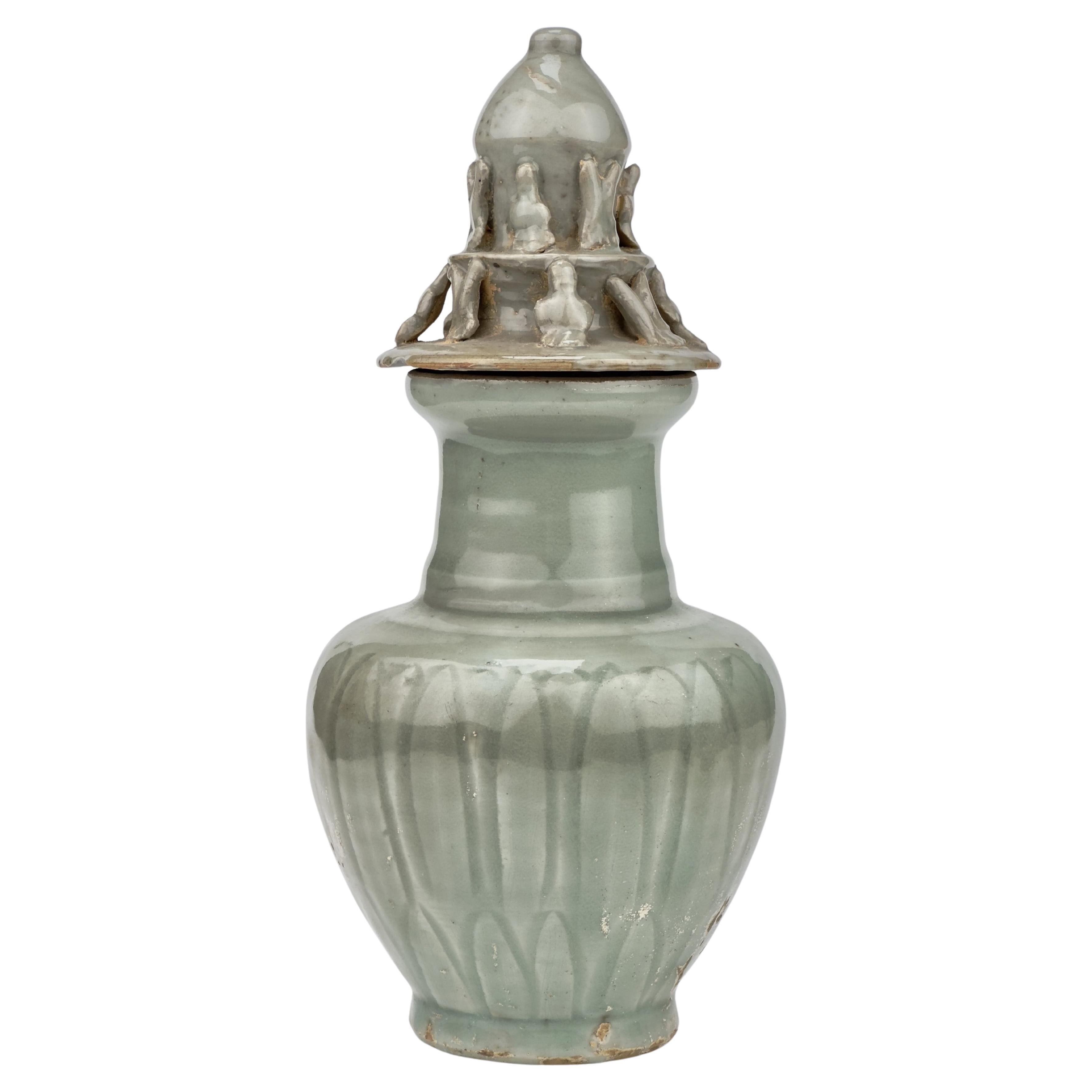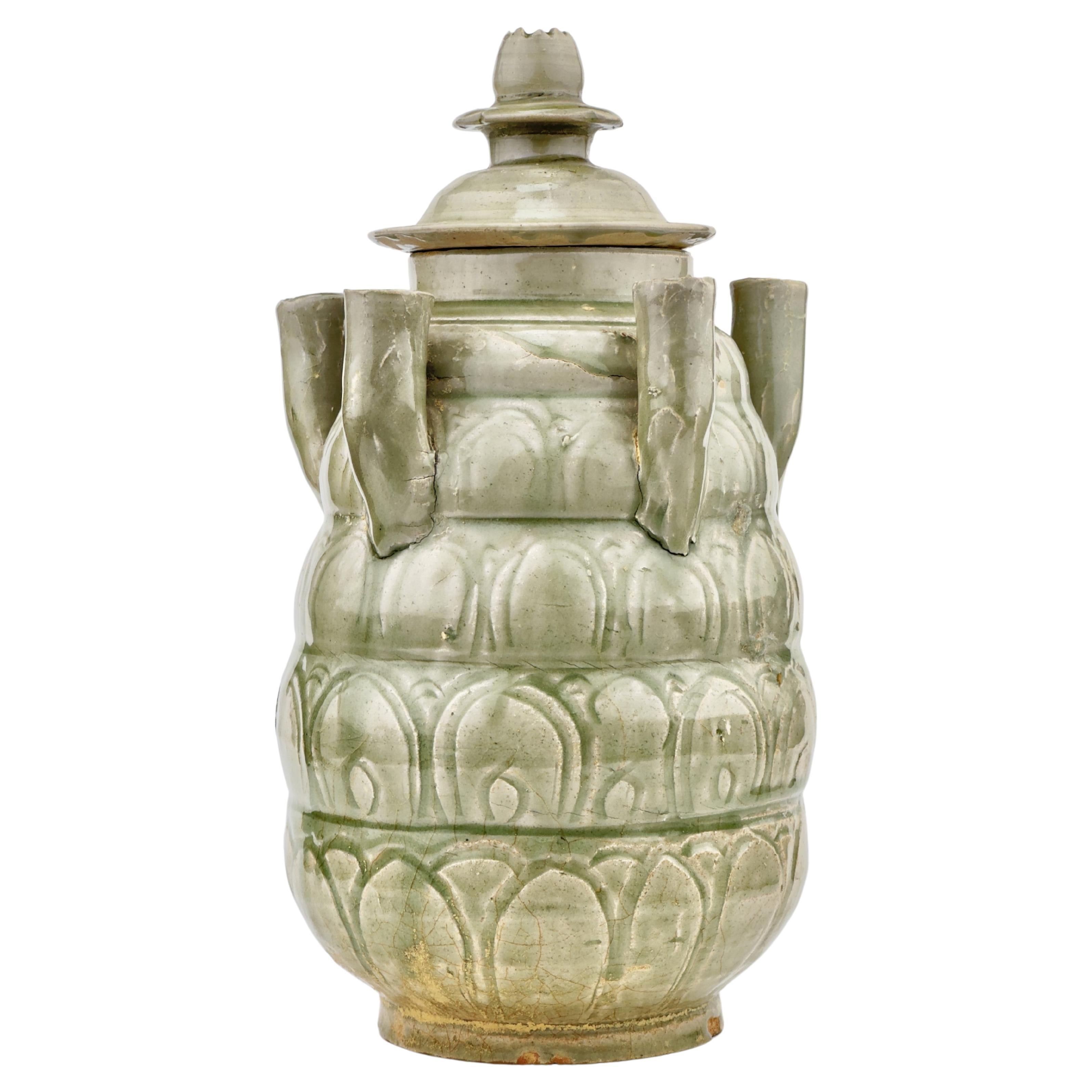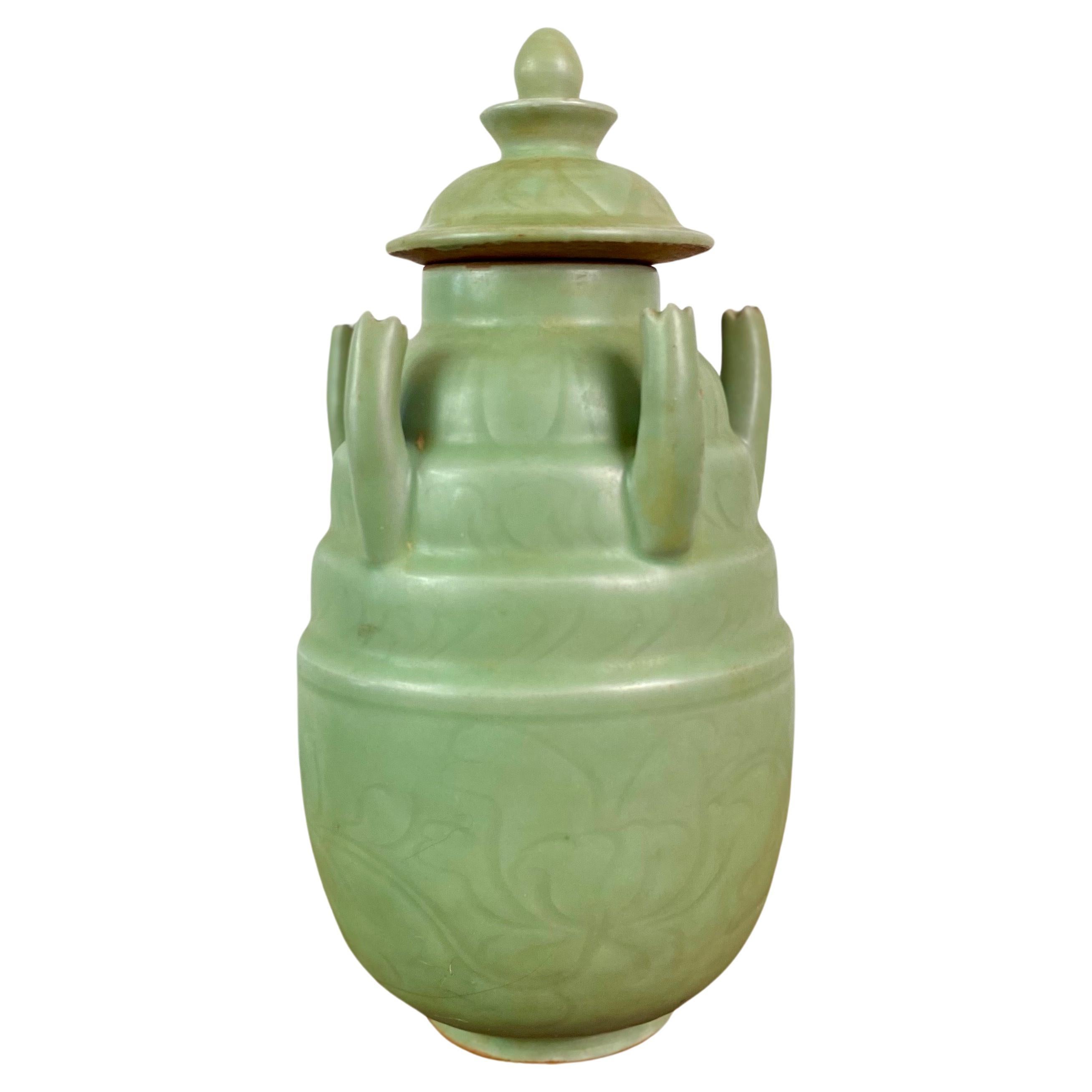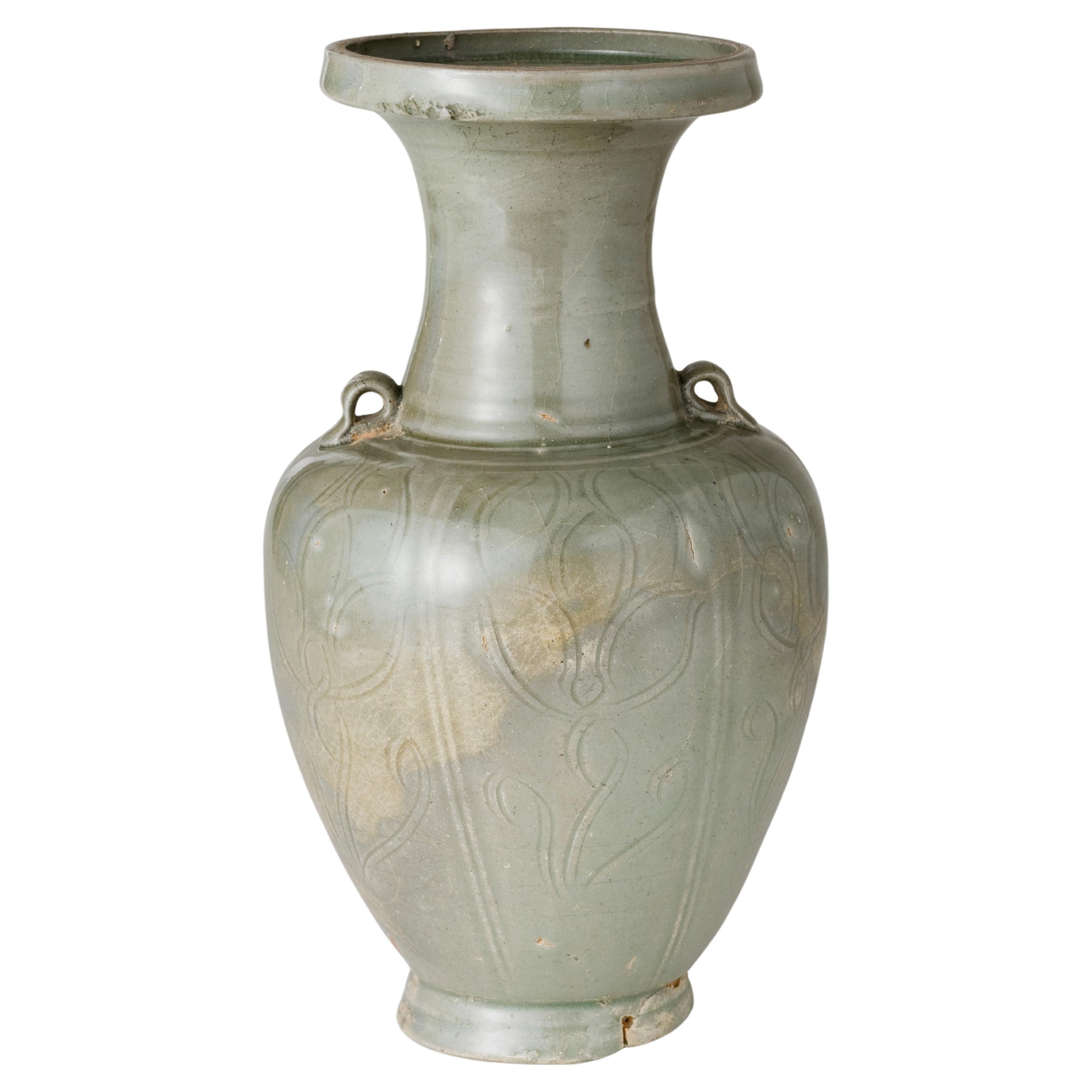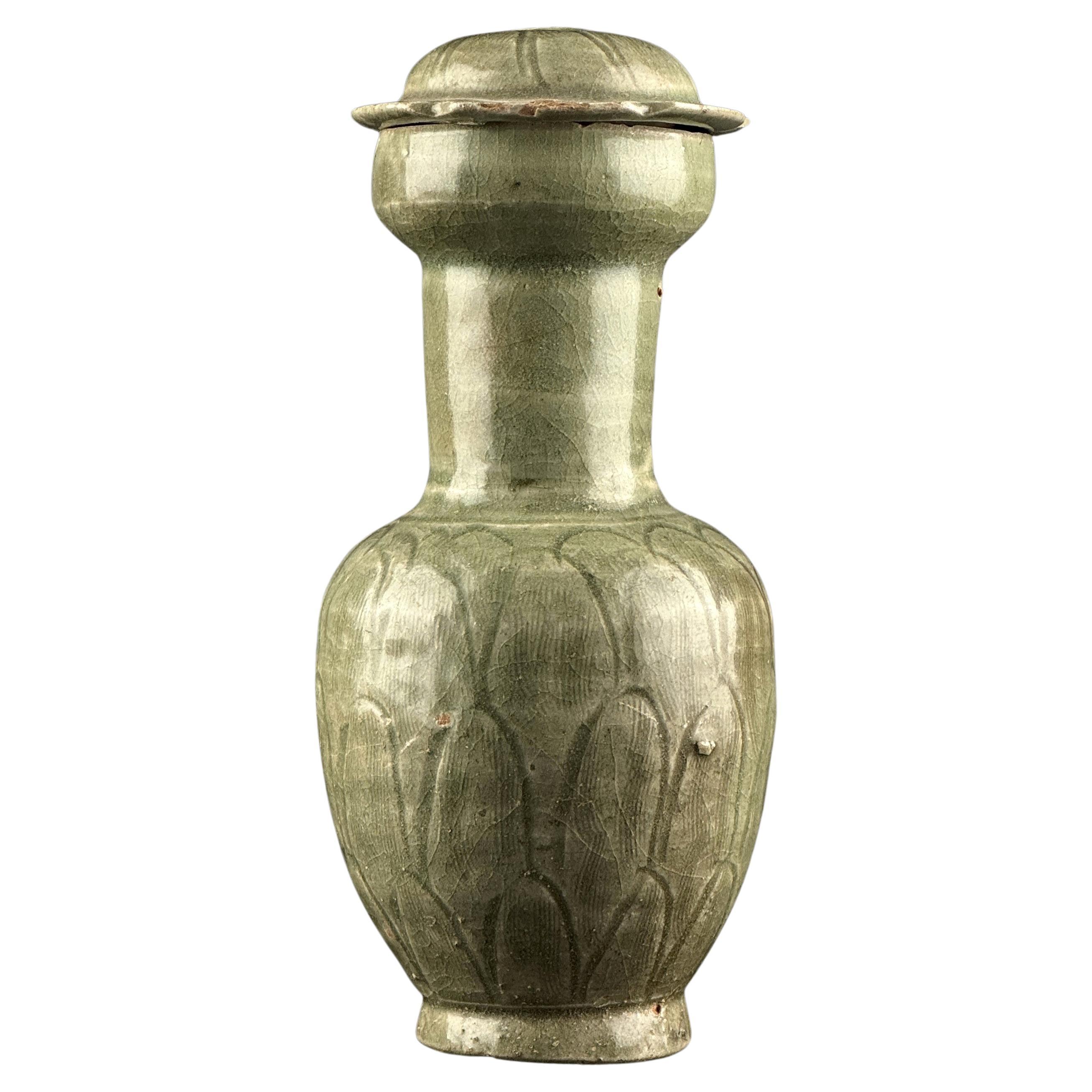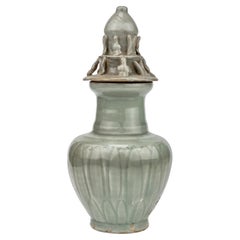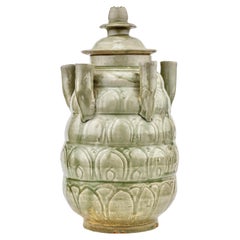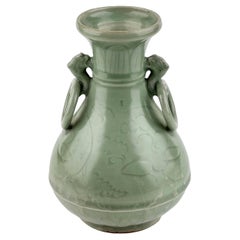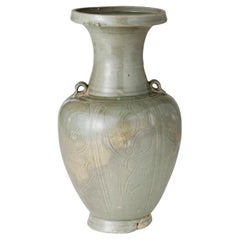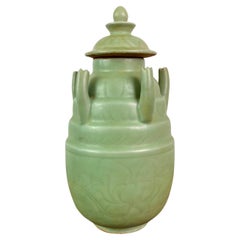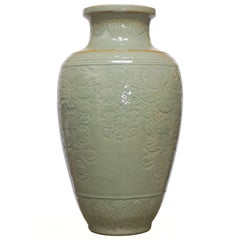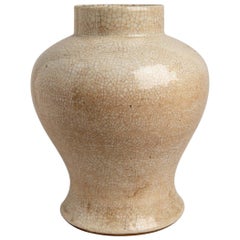Items Similar to A Rare 'Yue' Celadon Glazed Octagonal Vase, Western Jin Dynasty (266 - 316 AD)
Want more images or videos?
Request additional images or videos from the seller
1 of 14
A Rare 'Yue' Celadon Glazed Octagonal Vase, Western Jin Dynasty (266 - 316 AD)
$19,975
$79,90075% Off
£15,250.82
£61,003.2975% Off
€17,622.19
€70,488.7675% Off
CA$28,041.12
CA$112,164.4775% Off
A$31,254.75
A$125,018.9975% Off
CHF 16,398.29
CHF 65,593.1875% Off
MX$381,671.43
MX$1,526,685.7375% Off
NOK 207,638.06
NOK 830,552.2375% Off
SEK 196,249.55
SEK 784,998.1975% Off
DKK 131,522.08
DKK 526,088.3375% Off
About the Item
Finely potted with incurved facetted sides divided by raised ribs and set with two short lugs to the shoulder, the body rising to a short octagonal neck, the domed cover of conforming section, surrounded by an upturned rim and surmounted by a bud finial, applied overall with a celadon glaze of the period.
A related vase of this rare and charming form, in the Zhenjiang Museum, Zhenjiang, is illustrated in the Complete Collection of Chinese Ceramics. Song, vol. 8, Shanghai, 1999, pl. 52. Vases of related octagonal shape were produced at the Ding kilns, in Hebei province, and the qingbai kilns in Jiangxi province; see a Ding vase in the Palace Museum, Beijing, illustrated in Selection of Ding Ware. The Palace Museum’s Collection and Archaeological Excavation, Beijing, 2002, pl. 37; and a qingbai example, from the Meiyintang collection, illustrated in Regina Krahl, Chinese Ceramics from the Meiyintang Collection, vol. 3 (II), London, 2006, pl. 1590; and another carved with a floral scroll, included in the exhibition Song Ceramics from the Kwan Collection, Hong Kong Museum of Art, Hong Kong, 1994, cat. no. 105.
Period : Western Jin Dynasty (266 - 316 AD)
Type : Octagonal Vase
Medium : Yue celadon(Stoneware)
Provenance : The piece was acquired in Hong Kong in the year 1999.
Reference :
1) Sotheby's Hongkong 02 June 2016 - Chinese Art Lot 601
(Price : 1,062,500 HKD / Type : Closely related)
2) Christies Hongkong 30 May 2023 - Important Chinese Ceramics and Works of Art Lot 3318
(Price : 189,000 HKD / Type : Related)
3) Sotheby's London 16 May 2018 - Important Chinese Art Lot 68
(Price: 50,000 GBP / Type : Related)
* Yue Celadon
Yue celadon, also known as Yue ware, is a type of Chinese pottery with a celadon glaze, originating from the eastern Han dynasty in the Zhejiang province. The name 'Yue' comes from the Yue kilns which were among the earliest to develop the celadon technique. Yue ware is known for its jade-like glaze, which can range in color from bluish-green to olive green.
Yue celadon was highly regarded during its time and was the first Chinese ware to be imported in large quantities to the Middle East and Africa, significantly influencing the development of ceramics in those regions. The production of Yue ware continued to evolve, and during the Tang dynasty, it became more refined with more complex shapes and decorations. By the time of the Song dynasty, it had greatly influenced other kiln traditions, leading to the development of the classic longquan celadon, which became one of China’s most famous ceramic products.
Yue celadon traditionally embodies elements of auspiciousness and good fortune in Chinese culture. The jade-like celadon glaze is often associated with longevity and health. Various motifs and shapes inscribed on the pottery frequently symbolize luck and prosperity. For example, lotus patterns may represent purity and immortality, while animal figures like the lion symbolizes power, courage, and strength. Lions are considered protectors that ward off evil spirits and bring forth good luck. Furthermore, Yue celadon wares were commonly used as tomb offerings in ancient China, believed to bring fortune and well-being to the deceased in the afterlife.
About the Seller
4.8
Gold Seller
Premium sellers maintaining a 4.3+ rating and 24-hour response times
Established in 1999
1stDibs seller since 2023
38 sales on 1stDibs
Typical response time: <1 hour
- ShippingRetrieving quote...Shipping from: seoul, Korea South
- Return Policy
Authenticity Guarantee
In the unlikely event there’s an issue with an item’s authenticity, contact us within 1 year for a full refund. DetailsMoney-Back Guarantee
If your item is not as described, is damaged in transit, or does not arrive, contact us within 7 days for a full refund. Details24-Hour Cancellation
You have a 24-hour grace period in which to reconsider your purchase, with no questions asked.Vetted Professional Sellers
Our world-class sellers must adhere to strict standards for service and quality, maintaining the integrity of our listings.Price-Match Guarantee
If you find that a seller listed the same item for a lower price elsewhere, we’ll match it.Trusted Global Delivery
Our best-in-class carrier network provides specialized shipping options worldwide, including custom delivery.More From This Seller
View AllCarved 'Longquan' Celadon-glazed Funerary vase and cover, Song dynasty
Located in seoul, KR
The vase features a ribbed body, subtly enhancing its graceful contours, and is topped with a uniquely sculpted lid adorned with figurative elements.
Period : Song Dynasty
Type : Ce...
Category
Antique 15th Century and Earlier Hong Kong Antiquities
Materials
Celadon
$3,995 Sale Price
50% Off
Longquan Celadon Five-Spouted Jar, Northern Song Dynasty (AD 960~1127)
Located in seoul, KR
Thickly potted with an ovoid body of five horizontal lobes tapering toward the top, carries both aesthetic and practical values. The jar is intricately carved with rows of upright lo...
Category
Antique 15th Century and Earlier Hong Kong Antiquities
Materials
Celadon
$1,885 Sale Price
35% Off
Carved Longquan Celadon Vase, Yuan-Ming Dynasty
Located in seoul, KR
A graceful baluster form with a flared mouth, a rounded body, and a slightly raised foot. The vase features two intricate handles in the shape of animal figures holding large looped ...
Category
Antique 15th Century and Earlier Hong Kong Ming Antiquities
Materials
Celadon
$4,900 Sale Price
30% Off
Celadon Vase, Five Dynasties or Northern Song dynasty, 10th-11th Century
Located in seoul, KR
The form of Longquan celadon vases from the Northern Song dynasty evolved from an early design with a long neck and tapering body to a later ovoid body with a shorter neck. Over time, the glaze developed a more olive tone, and the carved decorations became more pronounced and intricate. Examples of such vases include one without a cover dated to the Yuanfeng era (1078~1085) and documented in literature, and another similar vase without loop handles preserved by the Qingyuan County Cultural Relics Bureau. An earlier example featuring loop handles and a lotus-like cover is also mentioned in historical texts.
The use of Longquan covered vases, especially as funerary jars for offerings like wine and grains, was highlighted by an inscription on a piece from the Sir Percival David Collection, London. This inscription wishes for the vessel to preserve fragrant wine for centuries, blessing the owner with prosperity, longevity, and a vast lineage, dated to the third year of the Yuanfeng period (1080). This practice was common in the regions of Southern Zhejiang and Northern Fujian. A similar celadon vase from the Linyushanren collection was auctioned at Christie’s Hong Kong, emphasizing the cultural and historical significance of these artifacts.
Period : Five Dynasties or Northern Song Dynasty
Type : Celadon, Zhejiang province
Medium : Celadon
Size : 31.5 cm(Height) x 11.5(Diameter)
Provenance : Acquired in late 1990s from Hongkong
Reference :
1) The British Museum image id - 01613270570
2) Christies New York 23–24 MAR 2023 - Important Chinese Ceramics and Works of Art - Lot 1012
(Price Range : USD 18,000 – USD 25,000 / Type : Related)
3) National Gallery of Victoria - Accession Number - AS5-1973
* Celadon from Five Dynasties (907~960) to the early Northern Song Dynasty (960~1127)
The period from the Five Dynasties (907~960) to the early Northern Song Dynasty (960~1127) marked a significant transitional phase in the development of Chinese celadon ceramics...
Category
Antique 15th Century and Earlier Hong Kong Antiquities
Materials
Celadon
$3,960 Sale Price
60% Off
Longquan Celadon 'Lotus Petal' Jar And Cover, Northern Song Dynasty)
Located in seoul, KR
The jar is sturdily potted with an oval shaped body carved with overlapping lotus petals below the straight neck. All covered with a crackled glaze of olive-green color with the exce...
Category
Antique 15th Century and Earlier Hong Kong Antiquities
Materials
Celadon
$3,495 Sale Price
50% Off
A Rare Longquan Celadon 'Peony' Vase Yuan-Ming Dynasty
Located in seoul, KR
This vase features a traditional vase coated with a clear and rich green celadon glaze. A fine network of crazing covers the surface. The neck is adorned with raised vine motifs, whi...
Category
Antique 15th Century and Earlier East Asian Ming Antiquities
Materials
Celadon
$57,850 Sale Price
35% Off
You May Also Like
Longquan Celadon 5-tube Covered Vase - 20th - Song style - Chine
Located in Beuzevillette, FR
Very pretty covered vase, pot, with 5 tubes / spouts from the Longquan Celadon Ovens.
The vase and its lid are in Celadon-glazed porcelain stoneware decorated with flowers and foliage.
This very pretty Covered Vase with five Wuguan Ping tubes, China, is very decorative and representative of Asian art and remarkable Chinese work...
Category
20th Century Chinese Qing Ceramics
Materials
Ceramic
Chinese Longquan Style Celadon Vase
Located in Rio Vista, CA
Large, Chinese Longquan style celadon vase with a stunning lotus leaf pattern underglaze and Greek key detail on the perimeter of t...
Category
20th Century Chinese Ming Ceramics
Materials
Porcelain
$900 Sale Price
25% Off
20th Century Chinese Celadon Lidded Porcelain Vase
Located in Queens, NY
"Chinese celadon ceramic vase with a gourd-shaped form wrapped in a tonal vine pattern and fitted with a ball finial-topped lid. (Similar vase in blue: NWL2041)
Chip near vase openi...
Category
20th Century Chinese Chinese Export Vases
Materials
Porcelain
Celadon Crakle Glaze Chinese Vase for Base Lamp
Located in Alessandria, Piemonte
Simple modern taste for this vintage crakle Chinese vase, also suitable for a table lamp.
(from my Chinese Collection).
nr. O/3202.
(special price for closing activities).
Category
Early 20th Century Chinese Archaistic Ceramics
Materials
Ceramic
Chinese Yaozhou Celadon Ceramic Bottle Vase
Located in Point Richmond, CA
Chinese Yaozhou Celadon Ceramic Bottle Vase, Northern Song, Shaanxi Province. A high fired bottle form with narrowed base, bulbous body, high shoulder,...
Category
Antique 15th Century and Earlier Chinese Other Ceramics
Materials
Ceramic, Celadon
A Pale Celadon Glazed Bottle Vase, Xuanhe Mark, 20th Century or Possibly Earlier
Located in ARMADALE, VIC
A Pale Celadon Glazed Bottle Vase, Xuanhe Mark, 20th Century or Possibly Earlier
Description:
The fine lobed body with flared scalloped floriate rim and raised foot. Incised with ru...
Category
20th Century Chinese Ceramics
Materials
Porcelain
$270 Sale Price
40% Off
Free Shipping
More Ways To Browse
Rare Glazed
Celadon Glazed
Antique China Ware
Large Celadon
Octagonal Vase
Celadon Glazed Vase
Rare Antique Asian Vases
Octagon China
Antique Celadon Vase
Song Dynasty Vase
Celadon Green Vase
Chinese Jade Vase
Chinese Green Glazed Animal
Pottery Cat
Chinese Vase Lion
African Carved Animals
Antique Chinese Celadon Vases
Celadon Jade
